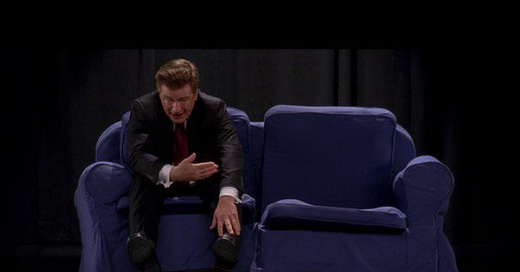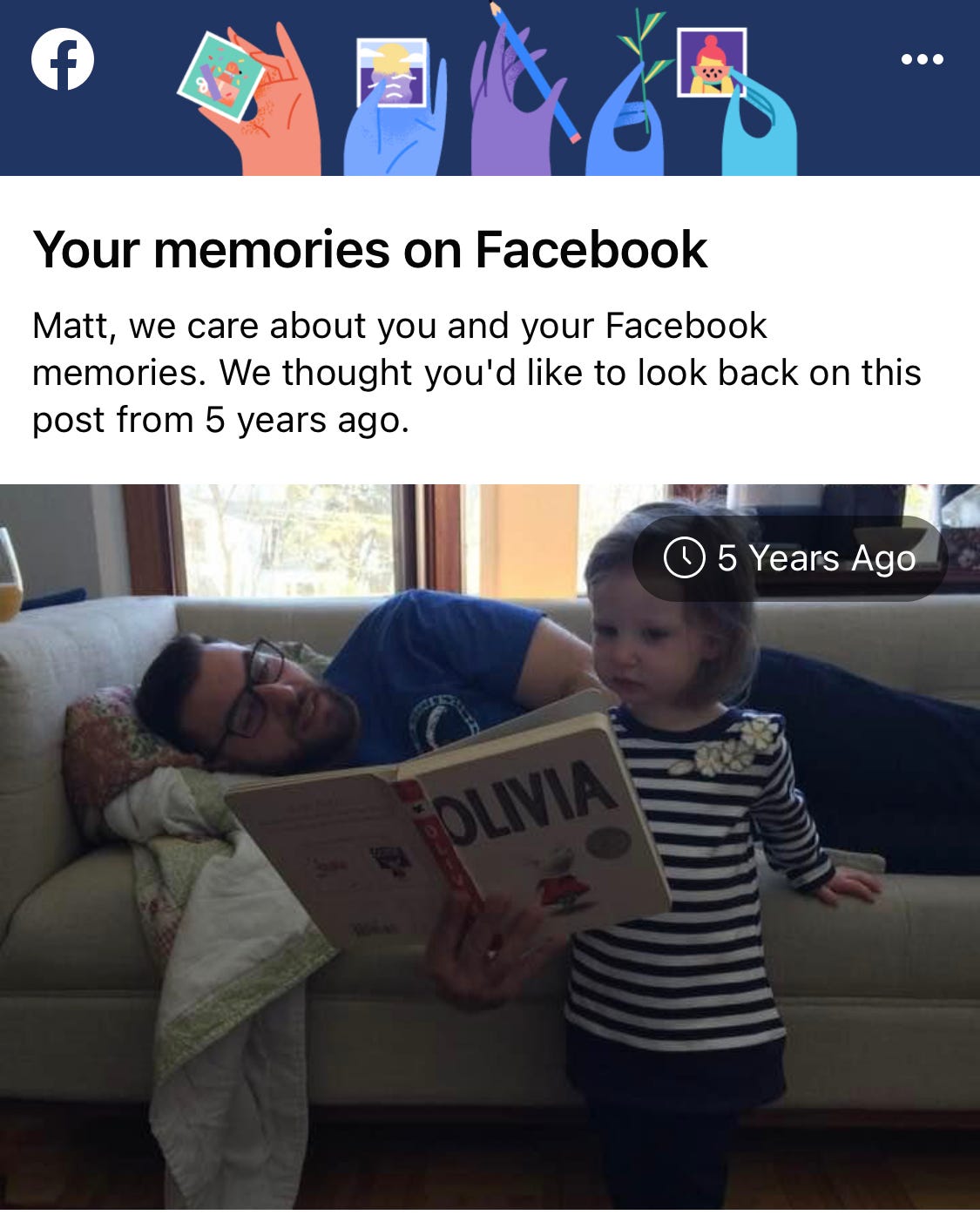About seven years ago, I decided to counter act my life of sitting almost all the time by doing the opposite thing: running a lot. I loved running. I still love it. It is, for me, a completely hedonistic pursuit. It became clear to me before long that “going out for a run” was the difference between a good day and a bad one. Surely I am the first dad who also happens to be a writer who has also figured out that running is good—it’s not a beat anybody has covered before.
I loved having some time to think. I used to listen to Joanna Newsom’s then-recent Divers on repeat, thinking through the puzzles of its gnomic lyrics and intricately developed speakers, how its songs laced together into a coherent whole. Newsom also had a song referencing “a good run” (can we discuss, at some point, the wonders of the human heart that this album was inspired by Andy Samberg?)
I’ve never been a particularly good athlete. In fact, my college roommate, Stu, tried to take my running with him a few times, and I had never hated anything more. So I was surprised when, after not too long, I could run 5, 10, 20k. I lost a lot of weight, and came to guard my runs more jealously than anything else I did. How wonderful, I thought, that, in order to undo the ill-effects of sitting, I had only to determine what the opposite thing was, and do that. This was a world that made sense: one could simply undo what one had done through exertion.
Alas. Five years ago this weekend, I had my first lower back spasm. The inciting incident was mysterious. Having run all winter for the first time, I was feeling good. Winter running is one of those un-obvious adult pleasures, like having your car detailed or reaching inbox zero. Enjoying being in the best shape of my life, I was carrying my daughter Ruthie down the street to her babysitter’s house when I slipped on some ice, and had to twist awkwardly so I didn’t drop her. I felt a slight pop, but no pain. Later than morning when I stepped out of the van at work, the moment my heel made contact with the parking lot, I felt the worst pain of my life and collapsed. I thought my appendix had burst. I was in so much pain that they sedated me in the emergency room. I had test after test—was it indeed an appendix? Had I slipped a disc or broken something? I also had to pee a lot, which opened up a series of more frightening possibilities. But test after test came back clear. My nurse practitioner, patient and solicitous, was at a loss.
Desperate for relief, and truly terrified by what was going on, I took my cousin’s advice and saw a chiropractor. He also, thank God, happened to be a physical therapist, and immediately knew what was wrong with me. He explained what was going on—“lower cross syndrome.” Many people—but mostly guys who sit all day and have put on some weight—attempt to undo all this sitting by getting into running. It is a direct and therefore appealing solution to a problem: what is the opposite of sitting all day? The dialectical clarity almost Hegelian in its purity: how does one negate sitting? By running, of course. The problem, however, is that running strengthens the muscles opposite to the ones which become weakened by sitting. Your strong hamstrings pull on your adductors and abductors—the muscles which wrap around your hips to your legs—until, like overly pulled rubber bands, the tension becomes too much and the pain is referred to your back. Hips do indeed lie.
Armed with this diagnosis, I was also given a prescription: a series of core exercises supplemented by yoga. Louche, but desperation can put doubt into abeyance.
As with any problem of contemporary life, when it comes to lower back pain, the internet has got you covered. The men’s lower back pain online space is interesting: it’s clear that savvy fitness entrepreneurs recognize the enormity of this contemporary affliction, even if I find it hard to believe any of the YouTube or instagram bros actually suffer from it. One of my favourites is Dean from “Man Flow Yoga” ( I know). He seems to understand this precise issue better than most: every few months he releases a revised “lower back pain yoga routine”—presumably internet search optimization requires revision. Happy baby, warrior 1, “inner tightening,” runners lunges, forward folds, hands on knees, cat-cow, cat-camel, hamstring stretches, bridges—a series of humiliating, quasi-pornographic motions which I previously found unspeakably embarrassing, but now do nonchalantly every-other-day at the Y with all the other lunchtime dads. There’s also an impossibly muscular German Brazilian Jiu Jitsu yoga YouTuber named Flo, who has a channel with his wife Bre—would you believe it’s called “Bre-athe and Flo-w?” Flo is more intense than Dean, but as I’ve moved out of crisis mode to prevention after each flair up, I’ve appreciated his Bavarian strictness.
There was a period of about a year when I could not sit on regular chairs for more than a couple of minutes. My wife and I have nice, vintage MCM dining room chairs, which felt, to me like 30 Rock’s Jack Donaghy’s “Kouchtown” couch—the American-made monstrosities eventually more useful to the CIA for “enhanced interrogation” than people who wanted to relax and watch Kabletown. Driving for extended period was worst of all—the combination of extending my leg while sitting would often make it impossible to get out of bed the next day.
This past weekend I went to a conference with good friends. I drove six and a half hours to and from Boston, flew, sat in uncomfortable chairs, and slept in an unfamiliar bed, and… I’m fine. This would have been unthinkable in the recent past, and I’m really grateful.
Like many problems with middle age, the answer to lower back pain is not the obvious one. So now I tell everyone who needs to hear it that, if you’re going to run a lot and you sit all day, you’ve got to “strengthen your core.” What a funny idea it is that one has a “core”—what is it? Well, it’s not one thing, but a sort of whole composed of parts of the greater whole that uses it. An eccentric core, in a way, since who wants to think about abdominal muscles as being so important? Surely the core of my being is not my belly, but my heart or my head? Perhaps there is something to this idea after all.
On reflecting on my five years of back pain, now under control, it occurs to me that the solution to most problems is not the direct, young man’s solution of intensity, negation, directness. Often enough, I’m able to look at my life and wonder: how do I strengthen a core to fix this problem? What’s the secret connection—the adductors and abductors of moral life— I’m failing to notice? With my kids and in my teaching, I’ve reached the conclusion, for instance, that it matters much less what I say, than how I say it. Affect is the most effective way of teaching, parenting.
But I think we like things to be clear and direct, and have definite cultural biases in this direction. This is not surprising, exactly. And, I like both of these things. It is my professional conviction, however, that the truth, when it needs to be told is often best told, as Emily Dickinson puts it, “slant”— “success in circuit lies.” I famously prefer the indirect Kierkegaard to Hegel (how funny that the latter might be the thinker for the young—but there’s something to it).
Even though we think we want directness, it is not how we learn. As a teacher and a dad, I spend a lot of time thinking about this. The entire challenge of education is inducing people to want to learn. You can’t make somebody want to do something. That’s coercion, not teaching. We often arrive where we want to be, at right angles, running parallel and perpendicular, not head-on. My lower back pain has taught me, with provocative indirection, that the difficult tasks of middle age, and maybe other ages, too, are trying your best to steady, stable, making small motions and changes, which, when they bear fruit, only seem precipitous, miraculous.






This is so good.
My wife and I just had a good giggle about "a series of humiliating, quasi-pornographic motions which I previously found unspeakably embarrassing, but now do nonchalantly every-other-day at the Y with all the other lunchtime dads."
And always enjoyable to find another dad/writer/runner pioneer. https://rossblankenship.substack.com/p/what-can-trail-running-teach-us-about
Cheers.